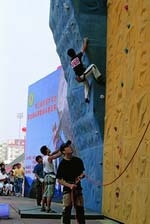Make more secure protection [Photos]
In my 13 years of climbing, it was never difficult to find a partner. However, finding a reassuring protector is a very difficult task. In the United States countless pioneers climbing under the rock walls and rock climbing halls, the display is always lazy behavior, but in contrast, "protection" requires knowledge, attention and patience. As a protector, he assumes responsibility for the climber (never distracting himself from chatting with others), retracting the master rope, grasping the timing, and moving the position. The precise combination of operations can provide a successful climb. Great help, and vice versa can lead to failure or even worse. Understand your equipment There are many kinds of protectors to choose from. First of all, you should carefully read the instructions for use, find a protector who can use this kind of protector in the local rocky field, and observe their skills quietly. Accurate communication is very important Never lift the climber's protection unless you are 100% certain that he has made such a request. Many accidental injuries and deaths are caused by this simple mistake. Do not let the rope interfere with the climber Observe the action of the climber to place the protection point, ready to send a rope. The slack rope should be suitable. On the one hand, the climber can easily get in the protection point, and at the same time, he must ensure that the climber does not face danger when falling below the protection point. Be cautious on the scale of the rope, especially when the climber is close to the ground. Climbers should stay at the original altitude For the climber, shouting "tighten" and sitting on the rope, but falling 3 meters, is very annoying. While protecting, pull back on the rope by reclining and sitting on the seatbelt, depending on the weight of your body. If possible, take in a long rope. Protector's security commitment Provide verbal assurances for your climber and tell him that you will always pay attention to him. "Protection" is not a resting activity for climbing the gap - it is a job, and it is your responsibility to ensure the safety of the climber. Protection area Make a free space with a radius of one arm around you. Obstacles such as bystanders, animals, backpacks, stones, loose loops, etc. must not enter this area. Finish the rope to avoid obstructions when sending the rope. Attention rope Between the protector and the first protection point, the rope needs to have a slight sag, which allows the climber to move freely without being hindered by the rope. Focus on the climber's buttocks - where the protector and the climber are connected so that you can judge whether he is climbing or adjusting his position and make sure the rope is of sufficient length to protect the climber from protection. Point safely back to the ground and hit a single fisherman's knot at the end of the rope to prevent accidental escape of the rope from the protector. body language Adjust the tightness of the rope by changing the distance between you and the rock wall; move it back and forth, close to or away from the rock wall, instead of repeatedly collecting and releasing the rope. The foot opposite the brakes stands on the front side of the body, and the hips are at a 45-degree angle to the rock wall. This posture allows the bones to align and reduces the painful neck pain often experienced by the protector. Use super feeling Predict possible hazards and make plans to deal with them. Try to estimate where the climber may fall, even if the action is simple. Plan how to prevent him from hitting corners or the ground. Shedding If the partner falls off, your response must be automatic - immediately lock the protector, then jump or move towards the rock wall, creating additional elasticity in the protection system, which happens to be the climber fell to the lowest point when. This will prevent the climber from shooting on the rock (this is a terrible impact)! Give him soft comfort on the pillow, not a fierce pause. Vacated When the rope's strength pulls your seatbelt, come to a warrior-like flying stunt! Prepare the fallen climber for psychological preparation. When it is vacated, raise your feet to cover the rock wall (non-brake balance). Your protector may get stuck in the first quick fix (some route protection points are very low), but in any case, absolutely guarantee that the brake rope must be gripped. Smile and enjoy the thrill of vacating! Climber Network Authorized Outdoor Information Network Fly Masks ,Horse Fly Veil,Horse Fly Masks,Horse Fly Bonnets And Veils NINGBO BRIGHT MAX CO., LTD. , https://www.equine-tool.com
